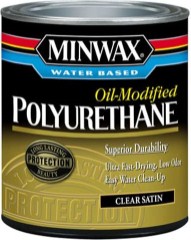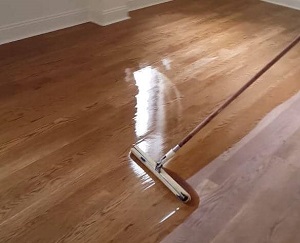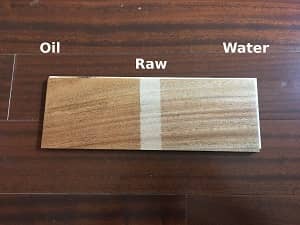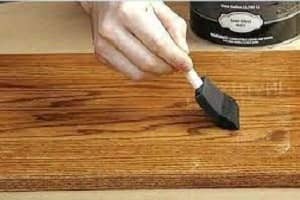The straightforward answer is no. Oil based polyurethane and water based polyurethane do not mix. This will be a problem if you want to add a top coat of oil-based urethane (or any other type of oil) over water-based urethane, because the two types of finish will repel each other and not accept a bond.
However, you could use either type of urethane to finish the project, but you would have to strip off the existing finish before applying a new one. The safest way is to lightly sand or plane a water-based top coat in order to get it perfectly flat with the substrate, then apply oil based urethane. Polyurethane Cloudy After Sanding problems and solutions.
Similarly, water-based urethane cannot be applied over oil based polyurethane. If you want to use only one finish, then it should be oil-based. Oil-based finishes are harder, more durable and easier to maintain than water-based finishes.
Oil-based urethane can last up to 40 years or more when applied properly, while water-based finishes are not as durable and usually require recoating in 5-10 years. On the other hand, water based finishes dry faster than oil, which is advantageous if you need to apply multiple coats in a single day.
Is Oil Based Or Water Based Polyurethane Stronger?

Oil based polyurethane has several advantages over water based polyurethane, including chemical resistance and solvent odor.
The biggest advantage of oil based polyurethane is that it typically contains 100% solid components, without any liquids.
When using a water based product you are never sure if the proper ratio of resin to hardener was used or if the material is contaminated with water.
Since oil based polyurethane contains no liquid components it will not be affected by any moisture that may have inadvertently gotten into the mixture or container.
Another advantage of oil based polyurethane is that it adheres to more substrates than water based polyurethane.
This means you can use one product for multiple applications, such as coating bare metal or over existing paint, instead of having to buy different products for each application.
In addition, oil based polyurethane is stronger, more durable and provides superior chemical resistance.
Water base products are only about 70% solid components containing 30% liquid solvents. The lower percentage of solids in water base products contributes to a shorter pot life which is the amount of time you have to work with the product before it begins to harden.
Another drawback of using a water based polyurethane is that it may not stick well to certain substrates, such as bare metal or fiberglass, and can even soften paint. On the other hand, oil based polyurethane will stick to almost any substrate and has a greater resistance to chemical spills than water based products.
Oil based polyurethanes also cure harder than water based products which means that the oil based product is stronger and more durable. Oil based polyurethane cure over a longer period of time than water based ones, giving you more working time and a higher quality finish. Oil based polyurethane typically has a longer pot life as well which can allow you to use the product on larger projects.
The amount of versatile applications between oil based and water based polyurethanes is about equal, however, oil based polyurethanes tend to be stronger and more durable than water based ones.
Water Based Polyurethane: The Best Choice for Your Project
The use of a water based polyurethane is becoming more popular in the furniture finishing world, due to its easier clean up and lower odor. One of the biggest fears people have of using a water based finish is that it will not be as robust as a solvent based lacquer, shellac or varnish.
Using a high quality, name brand water based polyurethane still provides several coats that can be built to provide great durability and ease of maintenance in the home.
Minwax water based polyurethane reviews

You can dramatically speed up the drying time by using Minwax Water Based Oil-Modified Polyurethane. It does it all in one easy coat! You can apply it by brush, roller, or spray gun. Just its thick consistency keeps it where you want it and elasticity keeps air flowing through the finish for superior drying. Minwax Water Based Oil-Modified Polyurethane protects wood, plastic, metal, and other hard surfaces that would be exposed to water damage.
Minwax Water Based Oil-Modified Polyurethane offers exceptional stain protection to minimize cracking, blistering, peeling, and crazing.
One of the problems with any kind of coating over an oil-based wood stain or dye is absorbency. Oil-based coatings are very porous, and unless sealed somehow, will prematurely wear away. This is where water-based polyurethane really shines. It penetrates deep into the wood’s pores to lock out moisture and seal the treatment inside, making it ideal for all types of interior finishing projects.
Water-based polyurethanes are available in a flat sheen or with a gloss finish. They are also available in a satin version with a slight sheen, however, it is not recommended for application over wood stained with an oil-based dye.
Using water-based polyurethane is very easy. It can be applied with a brush, rag, clean sponge, or paint pad on a pole. Just be sure to use a good quality brush or mop, as the bristles or pile will determine how well it spreads and levels out.
Water-based polyurethane is very easy to clean up, just soap and water with a rag works great. Make sure to wash your tools well to avoid coating them, as the material is hard to remove even with paint thinner.
The drying time can vary depending on the weather and humidity, but a good rule of thumb is 1 hour per coat at 70 degrees F, with light sanding between coats if needed. With three or four coats, your project will have outstanding protection and durability.
Can You Put Water Based Poly Over Oil Based Poly?

Yes, you can put water-based polyurethane over an existing finish of oil-based polyurethane or another type of paint. However, it’s important that you remove all loose paint first.
Removing all of the loose paint is an important step. If any oil-based paint is left on top of your polyurethane you will get bubbling underneath when it cures debonding from the floor. It’s advisable that you use a paint stripper with oxalic acid to remove all of the old finish completely before applying the water-based polyurethane.
Interesting fact Can you put polyurethane over Polycrylic?
What’s The Difference Between Water Based And Oil Based Polyurethane?

Water-based and oil-based polyurethane are two types of wood finishes in which wood is coated with a thin layer of various types of resins. The resin is derived from either an oil or water base, hence the name for each type. You will need to choose between oil-based or water-based polyurethane depending on your specific needs.
Both products serve as a protective sealant for bare wood surfaces, protecting them from wear and tear. They are durable, easy to apply and come in clear or colored varieties. The two main differences between the two types of finishes are the way each type cures and the fact that oil-based polyurethane is toxic.
How Long Does It Take Water Based Polyurethane To Dry?

Water-based polyurethane dries very quickly compared to oil-based type finishes. It will dry in about 4 hours and can be used after an hour or two. Keep in mind, however, that it is not fully cured until it has been sanded and allowed to dry again. The smaller the area you are working with, the faster it will cure.
What’s The Best Way To Put Polyurethane Over Wood?
First, identify the type of polyurethane you are using. If you are not sure, check with your hardware store clerk or look at the label on the can to see if it says for indoor or outdoor use. Some have a clear finish so be sure this is what you want before buying it.
Next, sand down all surfaces you wish to paint. This will help the paint adhere to the surface. Just be sure not to sand down any existing finish you have on your furniture. You can use a fine-grain sandpaper or use an electric sander for faster results.
Clean the surfaces with a damp cloth and let them dry completely before continuing. Finally, apply two coats of polyurethane with a brush or roller, allowing the first coat to dry for 15 minutes between applications.
The polyurethane will need about 72 hours to completely cure before it is ready for regular use. If you plan on applying more coats over your original two, be sure that is enough time has passed between each application. Keep in mind, after one hour you can wipe up any spills on the surface of your furniture with a dry cloth.
Can You Recoat Acrylic Flooring With Oil Based Polyurethane?

Cleaning and buffing the old finish before applying the new one is usually not an issue when recoating a water-based acrylic floor with an oil-based polyurethane. You can easily recoat acrylic flooring with oil based polyurethane.
How Do I Apply Water-based Polyurethane Over Oil-based Polyurethane

Make sure the surface is clean and free of grease or dirt before applying your water-based polyurethane over oil-based. If you suspect dirt or grease on the finish, use a detergent or a synthetic wool ball to clean it.
After cleaning, degloss the surface. Roughening with 120 grit sandpaper is wonderful. Make sure to clean it up well. You can also use a vacuum cleaner to remove any remaining dirt after roughening.
You have now cleaned and degreased the surface. Then apply the water-based polyurethane. You can use a sprayer or a lint-free cotton cloth to apply it.

